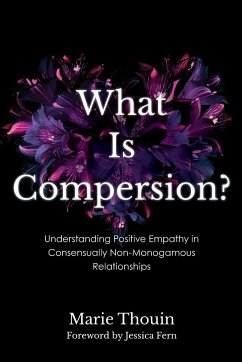Marie Thouin
What Is Compersion?
Understanding Positive Empathy in Consensually Non-Monogamous Relationships
Marie Thouin
What Is Compersion?
Understanding Positive Empathy in Consensually Non-Monogamous Relationships
- Broschiertes Buch
- Merkliste
- Auf die Merkliste
- Bewerten Bewerten
- Teilen
- Produkt teilen
- Produkterinnerung
- Produkterinnerung
The first comprehensive, interdisciplinary book on compersion. Drawing from philosophy, psychology, anthropology, and the helping professions, the author includes her own groundbreaking, rigorous research alongside vivid stories and practical advice from interviews with racially, ethnically, and gender-diverse people in CNM relationships.
Andere Kunden interessierten sich auch für
![Love and Freedom Love and Freedom]() Jorge N. FerrerLove and Freedom33,99 €
Jorge N. FerrerLove and Freedom33,99 €![Polyamorous Elders Polyamorous Elders]() Kathy LabriolaPolyamorous Elders46,99 €
Kathy LabriolaPolyamorous Elders46,99 €![A Clinician's Guide to Systemic Sex Therapy A Clinician's Guide to Systemic Sex Therapy]() Nancy GambesciaA Clinician's Guide to Systemic Sex Therapy36,99 €
Nancy GambesciaA Clinician's Guide to Systemic Sex Therapy36,99 €![The Many Faces of Polyamory The Many Faces of Polyamory]() Magdalena J. FosseThe Many Faces of Polyamory45,99 €
Magdalena J. FosseThe Many Faces of Polyamory45,99 €![Case Conceptualization in Couple Therapy Case Conceptualization in Couple Therapy]() Case Conceptualization in Couple Therapy46,99 €
Case Conceptualization in Couple Therapy46,99 €![Nuances of Sexual Consent Nuances of Sexual Consent]() Nuances of Sexual Consent43,99 €
Nuances of Sexual Consent43,99 €![The People's Book of Human Sexuality The People's Book of Human Sexuality]() Bianca I LaureanoThe People's Book of Human Sexuality27,99 €
Bianca I LaureanoThe People's Book of Human Sexuality27,99 €-
-
-
The first comprehensive, interdisciplinary book on compersion. Drawing from philosophy, psychology, anthropology, and the helping professions, the author includes her own groundbreaking, rigorous research alongside vivid stories and practical advice from interviews with racially, ethnically, and gender-diverse people in CNM relationships.
Produktdetails
- Produktdetails
- Diverse Sexualities, Genders, and Relationships
- Verlag: Bloomsbury Publishing Plc
- Seitenzahl: 314
- Erscheinungstermin: 7. Juni 2024
- Englisch
- Abmessung: 229mm x 152mm x 18mm
- Gewicht: 458g
- ISBN-13: 9781538183946
- ISBN-10: 1538183943
- Artikelnr.: 69874918
- Herstellerkennzeichnung
- Libri GmbH
- Europaallee 1
- 36244 Bad Hersfeld
- gpsr@libri.de
- Diverse Sexualities, Genders, and Relationships
- Verlag: Bloomsbury Publishing Plc
- Seitenzahl: 314
- Erscheinungstermin: 7. Juni 2024
- Englisch
- Abmessung: 229mm x 152mm x 18mm
- Gewicht: 458g
- ISBN-13: 9781538183946
- ISBN-10: 1538183943
- Artikelnr.: 69874918
- Herstellerkennzeichnung
- Libri GmbH
- Europaallee 1
- 36244 Bad Hersfeld
- gpsr@libri.de
Marie Thouin
Acknowledgments
Foreword by Jessica Fern
Introduction
What Is Compersion?
Compersion and Buddhism
Prevalence of Consensual Non-Monogamy
Mononormativity and Compersion
How Is Compersion Relevant to Monogamous People?
The Research behind This Book
Contributions and Relevance of This Book
Should Compersion Always Be the Goal?
Overview of the Book
Notes
Chapter 1: Developing a Non-Mononormative Relationship to Jealousy as a
Foundation for Compersion
The Entanglement of Jealousy and Mononormativity
Different Types of Jealousy
Essentialist, Cross-Cultural, and Socially Constructed Perspectives on
Jealousy
Jealousy and Power Dynamics in CNM Relationships
How CNM People Relate to Jealousy Differently: The Advent of
Non-Mononormative Jealousy
The Malleability of Jealousy
Notes
Part I: Components of Compersion
Chapter 2: Positive Empathy
What Is Empathy?
Participants' Accounts of Positive Empathy
Notes
Chapter 3: Gratitude
Participants' Accounts of Gratitude
Is Compersion Selfish or Selfless?
Notes
Part II: Dimensions of Compersion
Chapter 4: Two Kinds of Compersion: Attitudinal and Embodied
Attitudinal Compersion
Embodied Compersion
Is Compersion Necessary?
Congruence with Previous Research
Notes
Chapter 5: Spectrum of Compersion
Understanding the Spectrum
Is the Spectrum Linear?
Is the Spectrum Hierarchical?
Other Flavors of Compersion
Chapter 6: Coexistence of Jealousy and Compersion
Participants' Accounts of Jealousy and Compersion Coexisting
Comperstruggle
Fluidity between Jealousy and Compersion
Explanatory Frameworks for the Coexistence of Jealousy and Compersion
Part III: A Compersion Roadmap
Chapter 7: What Promotes Compersion?
Grouping 1: Individual Factors
Grouping 2: Relational Factors
Grouping 3: Social Factors
Notes
Chapter 8: What Hinders Compersion?
Grouping 1: Individual Factors
Grouping 2: Relational Factors
Grouping 3: Social Factors
Notes
Part IV: A Comprehensive Model of Compersion
Chapter 9: A Proposed Theory of Compersion
Congruency and Exceptions
A Dual Control Model of Compersion
Applying the Model in Practice
Notes
Part V: Social Lenses on Compersion
Chapter 10: The Role of Coming Out and Pride in Compersion
What Is Coming Out?
Identity Development and Coming Out for CNM People
CNM Resilience, Coming Out, and Compersion
CNM Identity Development Based on Perception of Innateness versus Choice
Chapter 11: Social Positionality and Compersion
The Research Process
Is Compersion a Privileged Emotion? The Surprising Impact of Compounded
Discrimination
Compersion as Resistance
Compersion and Age or Stage of Life
Compersion and Disability
Compersion and Gender
Sexual Orientation and Compersion
Race and Compersion
Socioeconomic Status and Compersion
Conclusion: The Double-Edged Sword of Otherness
Part VI: Concluding Thoughts
Chapter 12: Can Compersion Be Learned?
Learning by Creating a "Fertile Terrain"
Learning by Example
Learning by Unlearning
Learning by Shifting Paradigms
Learning through Practice
Learning by Cultivating Empathy
Learning by Doing
Conclusion
Notes
Chapter 13: Parting Words: Compersion, Personal Transformation, and Social
Change
Notes
References
Index
About the Author
Foreword by Jessica Fern
Introduction
What Is Compersion?
Compersion and Buddhism
Prevalence of Consensual Non-Monogamy
Mononormativity and Compersion
How Is Compersion Relevant to Monogamous People?
The Research behind This Book
Contributions and Relevance of This Book
Should Compersion Always Be the Goal?
Overview of the Book
Notes
Chapter 1: Developing a Non-Mononormative Relationship to Jealousy as a
Foundation for Compersion
The Entanglement of Jealousy and Mononormativity
Different Types of Jealousy
Essentialist, Cross-Cultural, and Socially Constructed Perspectives on
Jealousy
Jealousy and Power Dynamics in CNM Relationships
How CNM People Relate to Jealousy Differently: The Advent of
Non-Mononormative Jealousy
The Malleability of Jealousy
Notes
Part I: Components of Compersion
Chapter 2: Positive Empathy
What Is Empathy?
Participants' Accounts of Positive Empathy
Notes
Chapter 3: Gratitude
Participants' Accounts of Gratitude
Is Compersion Selfish or Selfless?
Notes
Part II: Dimensions of Compersion
Chapter 4: Two Kinds of Compersion: Attitudinal and Embodied
Attitudinal Compersion
Embodied Compersion
Is Compersion Necessary?
Congruence with Previous Research
Notes
Chapter 5: Spectrum of Compersion
Understanding the Spectrum
Is the Spectrum Linear?
Is the Spectrum Hierarchical?
Other Flavors of Compersion
Chapter 6: Coexistence of Jealousy and Compersion
Participants' Accounts of Jealousy and Compersion Coexisting
Comperstruggle
Fluidity between Jealousy and Compersion
Explanatory Frameworks for the Coexistence of Jealousy and Compersion
Part III: A Compersion Roadmap
Chapter 7: What Promotes Compersion?
Grouping 1: Individual Factors
Grouping 2: Relational Factors
Grouping 3: Social Factors
Notes
Chapter 8: What Hinders Compersion?
Grouping 1: Individual Factors
Grouping 2: Relational Factors
Grouping 3: Social Factors
Notes
Part IV: A Comprehensive Model of Compersion
Chapter 9: A Proposed Theory of Compersion
Congruency and Exceptions
A Dual Control Model of Compersion
Applying the Model in Practice
Notes
Part V: Social Lenses on Compersion
Chapter 10: The Role of Coming Out and Pride in Compersion
What Is Coming Out?
Identity Development and Coming Out for CNM People
CNM Resilience, Coming Out, and Compersion
CNM Identity Development Based on Perception of Innateness versus Choice
Chapter 11: Social Positionality and Compersion
The Research Process
Is Compersion a Privileged Emotion? The Surprising Impact of Compounded
Discrimination
Compersion as Resistance
Compersion and Age or Stage of Life
Compersion and Disability
Compersion and Gender
Sexual Orientation and Compersion
Race and Compersion
Socioeconomic Status and Compersion
Conclusion: The Double-Edged Sword of Otherness
Part VI: Concluding Thoughts
Chapter 12: Can Compersion Be Learned?
Learning by Creating a "Fertile Terrain"
Learning by Example
Learning by Unlearning
Learning by Shifting Paradigms
Learning through Practice
Learning by Cultivating Empathy
Learning by Doing
Conclusion
Notes
Chapter 13: Parting Words: Compersion, Personal Transformation, and Social
Change
Notes
References
Index
About the Author
Acknowledgments
Foreword by Jessica Fern
Introduction
What Is Compersion?
Compersion and Buddhism
Prevalence of Consensual Non-Monogamy
Mononormativity and Compersion
How Is Compersion Relevant to Monogamous People?
The Research behind This Book
Contributions and Relevance of This Book
Should Compersion Always Be the Goal?
Overview of the Book
Notes
Chapter 1: Developing a Non-Mononormative Relationship to Jealousy as a
Foundation for Compersion
The Entanglement of Jealousy and Mononormativity
Different Types of Jealousy
Essentialist, Cross-Cultural, and Socially Constructed Perspectives on
Jealousy
Jealousy and Power Dynamics in CNM Relationships
How CNM People Relate to Jealousy Differently: The Advent of
Non-Mononormative Jealousy
The Malleability of Jealousy
Notes
Part I: Components of Compersion
Chapter 2: Positive Empathy
What Is Empathy?
Participants' Accounts of Positive Empathy
Notes
Chapter 3: Gratitude
Participants' Accounts of Gratitude
Is Compersion Selfish or Selfless?
Notes
Part II: Dimensions of Compersion
Chapter 4: Two Kinds of Compersion: Attitudinal and Embodied
Attitudinal Compersion
Embodied Compersion
Is Compersion Necessary?
Congruence with Previous Research
Notes
Chapter 5: Spectrum of Compersion
Understanding the Spectrum
Is the Spectrum Linear?
Is the Spectrum Hierarchical?
Other Flavors of Compersion
Chapter 6: Coexistence of Jealousy and Compersion
Participants' Accounts of Jealousy and Compersion Coexisting
Comperstruggle
Fluidity between Jealousy and Compersion
Explanatory Frameworks for the Coexistence of Jealousy and Compersion
Part III: A Compersion Roadmap
Chapter 7: What Promotes Compersion?
Grouping 1: Individual Factors
Grouping 2: Relational Factors
Grouping 3: Social Factors
Notes
Chapter 8: What Hinders Compersion?
Grouping 1: Individual Factors
Grouping 2: Relational Factors
Grouping 3: Social Factors
Notes
Part IV: A Comprehensive Model of Compersion
Chapter 9: A Proposed Theory of Compersion
Congruency and Exceptions
A Dual Control Model of Compersion
Applying the Model in Practice
Notes
Part V: Social Lenses on Compersion
Chapter 10: The Role of Coming Out and Pride in Compersion
What Is Coming Out?
Identity Development and Coming Out for CNM People
CNM Resilience, Coming Out, and Compersion
CNM Identity Development Based on Perception of Innateness versus Choice
Chapter 11: Social Positionality and Compersion
The Research Process
Is Compersion a Privileged Emotion? The Surprising Impact of Compounded
Discrimination
Compersion as Resistance
Compersion and Age or Stage of Life
Compersion and Disability
Compersion and Gender
Sexual Orientation and Compersion
Race and Compersion
Socioeconomic Status and Compersion
Conclusion: The Double-Edged Sword of Otherness
Part VI: Concluding Thoughts
Chapter 12: Can Compersion Be Learned?
Learning by Creating a "Fertile Terrain"
Learning by Example
Learning by Unlearning
Learning by Shifting Paradigms
Learning through Practice
Learning by Cultivating Empathy
Learning by Doing
Conclusion
Notes
Chapter 13: Parting Words: Compersion, Personal Transformation, and Social
Change
Notes
References
Index
About the Author
Foreword by Jessica Fern
Introduction
What Is Compersion?
Compersion and Buddhism
Prevalence of Consensual Non-Monogamy
Mononormativity and Compersion
How Is Compersion Relevant to Monogamous People?
The Research behind This Book
Contributions and Relevance of This Book
Should Compersion Always Be the Goal?
Overview of the Book
Notes
Chapter 1: Developing a Non-Mononormative Relationship to Jealousy as a
Foundation for Compersion
The Entanglement of Jealousy and Mononormativity
Different Types of Jealousy
Essentialist, Cross-Cultural, and Socially Constructed Perspectives on
Jealousy
Jealousy and Power Dynamics in CNM Relationships
How CNM People Relate to Jealousy Differently: The Advent of
Non-Mononormative Jealousy
The Malleability of Jealousy
Notes
Part I: Components of Compersion
Chapter 2: Positive Empathy
What Is Empathy?
Participants' Accounts of Positive Empathy
Notes
Chapter 3: Gratitude
Participants' Accounts of Gratitude
Is Compersion Selfish or Selfless?
Notes
Part II: Dimensions of Compersion
Chapter 4: Two Kinds of Compersion: Attitudinal and Embodied
Attitudinal Compersion
Embodied Compersion
Is Compersion Necessary?
Congruence with Previous Research
Notes
Chapter 5: Spectrum of Compersion
Understanding the Spectrum
Is the Spectrum Linear?
Is the Spectrum Hierarchical?
Other Flavors of Compersion
Chapter 6: Coexistence of Jealousy and Compersion
Participants' Accounts of Jealousy and Compersion Coexisting
Comperstruggle
Fluidity between Jealousy and Compersion
Explanatory Frameworks for the Coexistence of Jealousy and Compersion
Part III: A Compersion Roadmap
Chapter 7: What Promotes Compersion?
Grouping 1: Individual Factors
Grouping 2: Relational Factors
Grouping 3: Social Factors
Notes
Chapter 8: What Hinders Compersion?
Grouping 1: Individual Factors
Grouping 2: Relational Factors
Grouping 3: Social Factors
Notes
Part IV: A Comprehensive Model of Compersion
Chapter 9: A Proposed Theory of Compersion
Congruency and Exceptions
A Dual Control Model of Compersion
Applying the Model in Practice
Notes
Part V: Social Lenses on Compersion
Chapter 10: The Role of Coming Out and Pride in Compersion
What Is Coming Out?
Identity Development and Coming Out for CNM People
CNM Resilience, Coming Out, and Compersion
CNM Identity Development Based on Perception of Innateness versus Choice
Chapter 11: Social Positionality and Compersion
The Research Process
Is Compersion a Privileged Emotion? The Surprising Impact of Compounded
Discrimination
Compersion as Resistance
Compersion and Age or Stage of Life
Compersion and Disability
Compersion and Gender
Sexual Orientation and Compersion
Race and Compersion
Socioeconomic Status and Compersion
Conclusion: The Double-Edged Sword of Otherness
Part VI: Concluding Thoughts
Chapter 12: Can Compersion Be Learned?
Learning by Creating a "Fertile Terrain"
Learning by Example
Learning by Unlearning
Learning by Shifting Paradigms
Learning through Practice
Learning by Cultivating Empathy
Learning by Doing
Conclusion
Notes
Chapter 13: Parting Words: Compersion, Personal Transformation, and Social
Change
Notes
References
Index
About the Author









